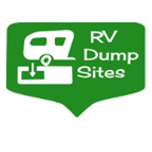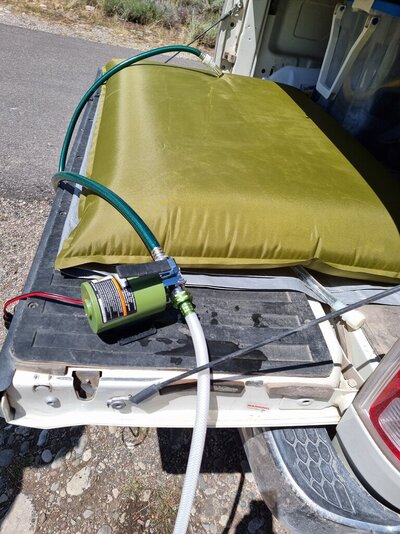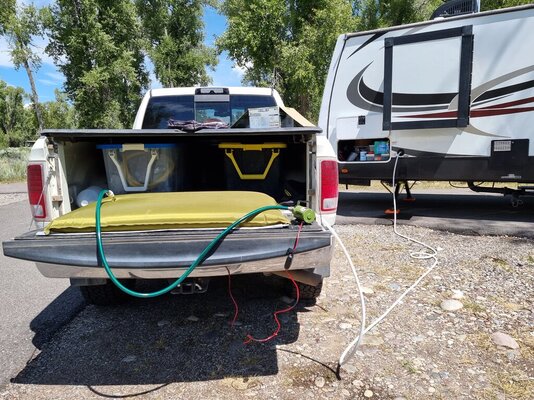Regardless of the style of RV (5r, TT, C, Super C), you shower, wash dishes, and may have a washing machine. How do you refill your freshwater tank? I would imagine it's done at home, via garden hose, before leaving. But how is this handled when on the road, if not at a full service campground?
You are using an out of date browser. It may not display this or other websites correctly.
You should upgrade or use an alternative browser.
You should upgrade or use an alternative browser.
New to Forum - How is Freshwater Refilling Handled While Vacationing?
- Thread starter kailor
- Start date
The friendliest place on the web for anyone with an RV or an interest in RVing!
If you have answers, please help by responding to the unanswered posts.
If you have answers, please help by responding to the unanswered posts.
Tulecreeper
Well-known member
I've been lucky enough to find restaurants that would let me use their hose bib to fill up. I've never had to pay, but I imagine I would have given them something for the water if I had to. It helps if you're in the middle of ordering something when you ask.Regardless of the style of RV (5r, TT, C, Super C), you shower, wash dishes, and may have a washing machine. How do you refill your freshwater tank? I would imagine it's done at home, via garden hose, before leaving. But how is this handled when on the road, if not at a full service campground?
Since what goes in must come out, people generally fill the fresh water at the same time they dump their waste tanks.Regardless of the style of RV (5r, TT, C, Super C), you shower, wash dishes, and may have a washing machine. How do you refill your freshwater tank? I would imagine it's done at home, via garden hose, before leaving. But how is this handled when on the road, if not at a full service campground?
Full hookup (electric/water/sewer) sites in campgrounds obviously have potable water, and most (but definitely not all) dump stations in non-full hookup campgrounds have potable water available (and even if it's available it might be the kind of spigot where you have to hold it down the whole time you're using it, and it might be located a distance from the dump station).
There are also dump stations at other places, like highway rest areas or gas stations, that might have potable water available but it's by no means a sure thing. Some dump stations are just a drain, with no water available at all.
And as always, access gets more complicated the bigger your RV.
Some towns (out West anyway) have dump stations and potable water.
This is a good resource if you bear in mind it may not be 100% accurate.

 rvdumpsites.net
rvdumpsites.net
As mentioned above, forest campgrounds, national park campgrounds, RV Parks, gas stations even some stores allow water fill, some free, some charge.
Make sure you have the appropriate hose.
This is a good resource if you bear in mind it may not be 100% accurate.
Map of RV Dump Stations | Find a Dump Station Near You
Finding RV dump stations is easy! Use our interactive map to find the closest dump station.
 rvdumpsites.net
rvdumpsites.net
As mentioned above, forest campgrounds, national park campgrounds, RV Parks, gas stations even some stores allow water fill, some free, some charge.
Make sure you have the appropriate hose.
Kirk
Well-known member
With most modern RVs, the fresh water tank size is pretty much matched to the waste tank capacities, so you will need to dump most of the times that you need water. Many RV parks will allow you to do both for a reasonable fee. Many truck stops also have facilities for both, again for a modest fee. Most state and federal campgrounds will have both potable water and a dump station available for use by those who spend a night there and often for a small fee if you do not stay there. The Bureau of Land Management has areas called LTVA's that you can spend extended time for a minimal fee and they usually have water and a dump station. Water is more available than dump stations as most fuel stations will allow you to get water and often free but only a few will have a dump station. There is nowhere that it is acceptable to just dump the black tank on the ground or into a storm sewer and almost none that will allow you to empty the gray water that way so dump stations are just as important as a water supply.How do you refill your freshwater tank?
Isaac-1
Well-known member
Our coach has 80 gal fresh, 40 gal gray and 40 gallon black tank, when my wife and I are traveling together this typically gives us at least a 5 day water supply with a safety margin. In our case with the way we travel, typically up to 2-3 weeks at a time for up to 75 nights per year, though that counts some solo trips, or trips where my wife flies and meets me at the tourist destination part of the trip. Finding dump stations / refill fresh water has never been much of an issue, as we will typically stop in full service campground at least once per week to do laundry, while there we will dump and refill, etc. Though we have also used free public dump stations at rest areas, some of which have potable fresh water fill available (typically located at least 100 ft from the dump station which may have wash down non-potable water). We have seen other options for potable fresh water, such as at truck stops, some free, some not, ... We even once used a pay ($10?) dump / refill station at a museum in I think Wyoming, that was in 2017 the day after the big solar eclipse, and the free dump stations at multiple rest areas were closed / overflowing.
Kirk
Well-known member
It is important to remember that the tank sizes are a vital part of how long between fill/dump operations. Another is the ability to conserve water. Some do very well and others poorly so there is no standard number of gallons per day, per person.Our coach has 80 gal fresh, 40 gal gray and 40 gallon black tank,
LarsMac
Well-known member
Most RV park campsites have fresh water connections, so all you need to do is connect the fresh water supply to your tank and fill it. I keep a filter and hose specifically for refilling my tank, and only fill from the park's water supply at the campsite. (and only if I liked the look of the water while camping.)
I never use the water supply at a dump site to refill fresh water. (Something about "Bathroom water" from when I was a kid, probably.)
I never use the water supply at a dump site to refill fresh water. (Something about "Bathroom water" from when I was a kid, probably.)
CharlesinGA
Well-known member
You want to carry a hose with you of course, and if you are out west, take every advantage to top the tank. Most Maverik gas stations have free potable water. Never use water at a dump station that is clearly marked non-potable and it doesn't hurt to carry a spray bottle with bleach in it to spray off water hydrants in case some fool decided to use it to flush out their dump hose. That even goes for your campsite with full hookups.
Kailor,
In lots of years with this coach, we have paid for less than a dozen campgrounds. When we do, of course we put on potable and dump the black. While there are lots of places to dump, it is sometimes a hint for potable. We start with Bass Pro and Cabela's. Both have to have water available for the boats they service. Lots of other places do as well. It can take some looking.
Matt_C
In lots of years with this coach, we have paid for less than a dozen campgrounds. When we do, of course we put on potable and dump the black. While there are lots of places to dump, it is sometimes a hint for potable. We start with Bass Pro and Cabela's. Both have to have water available for the boats they service. Lots of other places do as well. It can take some looking.
Matt_C
tlmgcamp
Well-known member
- Joined
- Jul 16, 2016
- Posts
- 840
Upon arrival for our 3 trips to Assateague State Park we filled the water tank at the office before going to to our site
IBTripping
Well-known member
Just a note that you should carry a hose designed for drinking water. Other hoses, such as garden hoses, may leach bad chemicals. Most Walmarts carry Camco RV fresh water hoses.
Ex-Calif
Well-known member
You will get a feel for your water usage and start being able to plan ahead. I started by drinking camp water but switched to bottled water for drinking. I'll shower, cook and brush teeth with camp water but I found taste varied and while probably safe I just didn't like it and bottled water is cheap.But how is this handled when on the road, if not at a full service campground?
I never filled water at a dump station spigot. There are too many bad places that the previous folks can (and do) stick that nozzle.
The simple answer is that for me, I plan a stop every 5-7 days at a full service camp site and fill up at the RV pad.
UTTransplant
Well-known member
For all the concerns about filling up at a dump station, there are lots of dump stations where the potable water spigot is quite a ways from the sanitary dump. I have no problems filling at those sites. I agree that I don’t fill at potable faucets right next to the sanitary dump unless I sanitize the faucet first. Then again, at campgrounds the two dump and fresh water are frequently within inches of each other!
Mark_K5LXP
Well-known member
Generally the fill/dump issue is resolved by staying somewhere with those facilities every few days. I've also paid dump fees at truck stops and gas stations enroute. The few times I've topped off water outside that cycle amounted to talking to someone at the business we're at and asking if I could have some water, with the success rate so far being 100%. There's no practical way to pay for it but doing some business at the establishment is usually sufficient gratitude. Water is something you don't get surprised about, or if you run low you're stranded. I know I've got 5 days minimum, if you're traveling at all there will surely be an opportunity within that span somewhere.
Mark B.
Albuquerque, NM
Mark B.
Albuquerque, NM
Adventurous Traveler
Well-known member
I think the seasoned "professional" RV'ers pretty much answered the question posed by the OP.
In our 15 years of RV'ing we have never come across the need to stop at a fuel rest stop or anywhere else to refill our water tank. Normal campground stops every two or three days during extended trips always met our water demand. Now, I'm on my third class A with a 65-gallon freshwater tank and my two prior rigs had tanks I believe about the same size. Class C's and many TTs usually have smaller capacity freshwater tanks and dump tanks. Like Ex-Calif, we use brought along water (one-gallon jugs filled at home) to use for drinking, coffee, bike water bottles, and such. We'll use the CG or water tank water for dishes, showers, toilet, teeth brushing, or taking an aspirin.
In our 15 years of RV'ing we have never come across the need to stop at a fuel rest stop or anywhere else to refill our water tank. Normal campground stops every two or three days during extended trips always met our water demand. Now, I'm on my third class A with a 65-gallon freshwater tank and my two prior rigs had tanks I believe about the same size. Class C's and many TTs usually have smaller capacity freshwater tanks and dump tanks. Like Ex-Calif, we use brought along water (one-gallon jugs filled at home) to use for drinking, coffee, bike water bottles, and such. We'll use the CG or water tank water for dishes, showers, toilet, teeth brushing, or taking an aspirin.
DutchmenSport
Well-known member
It all depends upon how you "camp". If you Boondock in remote places, yes ... water and dumping will be more problematic.
But, if you are in established campgrounds, water will be available somewhere. You will either have water at the campsite or there will be a common water spigot somewhere for everyone to use. Where those are located is 100% different at every campground.
100% of our camping is at established campgrounds or at home, or someone elses house/property. We always have water available, but may not be able to hook up to water. Under those conditions, water is transported between the water spigot and the camper. I use a water transfer pump to fill the tank on my camper. The pump is 120v AC, but I also have a 400 watt inverter that runs off the truck battery (cigarette lighter plug), so I can always get the AC power there if we are at a location with no AC electricity.
Here's how I do it:
https://i.imgur.com/Ssnf8ym.jpg
https://i.imgur.com/rwJUfUZ.jpg
https://i.imgur.com/I2oVQoY.jpg
But, if you are in established campgrounds, water will be available somewhere. You will either have water at the campsite or there will be a common water spigot somewhere for everyone to use. Where those are located is 100% different at every campground.
100% of our camping is at established campgrounds or at home, or someone elses house/property. We always have water available, but may not be able to hook up to water. Under those conditions, water is transported between the water spigot and the camper. I use a water transfer pump to fill the tank on my camper. The pump is 120v AC, but I also have a 400 watt inverter that runs off the truck battery (cigarette lighter plug), so I can always get the AC power there if we are at a location with no AC electricity.
Here's how I do it:
https://i.imgur.com/Ssnf8ym.jpg
https://i.imgur.com/rwJUfUZ.jpg
https://i.imgur.com/I2oVQoY.jpg
Here is our solution to avoid moving the trailer
Not cheap for what it is but it's very handy and packs away to a very small size - A4 paper size.
We can fill our 60L fresh water tank with one fill (usually some left in bag).
We have a small Harbor Freight pump to transfer it, our tank is at the truck end.
Not cheap for what it is but it's very handy and packs away to a very small size - A4 paper size.
We can fill our 60L fresh water tank with one fill (usually some left in bag).
We have a small Harbor Freight pump to transfer it, our tank is at the truck end.
Attachments
Lou Schneider
Site Team
- Joined
- Mar 14, 2005
- Posts
- 13,303
For several years I used an old queen size waterbed mattress. Flushed it out before I started using it for water transport and figured the water wouldn't be in it long enough to absorb any significant amount of residual contaminants.Here is our solution to avoid moving the trailer
Not cheap for what it is but it's very handy and packs away to a very small size - A4 paper size.
We can fill our 60L fresh water tank with one fill (usually some left in bag).
We have a small Harbor Freight pump to transfer it, our tank is at the truck end.


